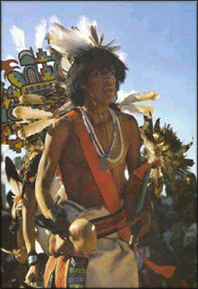
Brief History of the Hopi People
The Hopi people have occupied the lands they currently inhabit for at least the past 1,000 years. It is believed by some that the Hopi have even occupied their current lands for the past 10,000 years although this is fairly controversial (Williams, 2002). The inhabitance of Hopi on Hopi land is believed to be the longest history of occupation of a single area amongst all Native American tribes within the United States. Today, the Hopi Reservation is a mere 9% of the original tutsqua in which the Hopi have to contend with the Navajo people’s occupation of their land (Hopi Tribe, 2001).
The Hopi people as far back as the 1500s have had a highly developed and elaborate ceremonial cycle, complex social organization network and an advanced agricultural system. The Hopi are also known as the people of the law; they are rule bound, religious and self-righteous. Presently today, the Hopi people and culture retains much of its hunter-gatherer past. In the past the men would hunt and the women would take care of the children and be concerned with the gathering, however today, since there is very little game the men are now in charge of the farming and livestock (Benedek, 1992, p.47). It is believed that the Hopi changed from hunting and gathering way of life to a sedentary farming lifestyle due to population increases and reduction of available forage. As well, like the Navajo the Hopi were in some cases sheepherders who use sheep to cultivate wool production.
 |
| Source: http://www.hopi.org/about_the_hopi.htm |
The current problems regarding the Hopi and their land dispute with the Navajo stems from the war against the United States and Mexico in 1848 where the Mexicans lost and the lands of the Pueblo, Zuni and Hopi began to be controlled by the United States government in Washington. However, even though the Hopi had rights of citizenship while being part of Mexico within the US policy, Native American nations were wards of the United States government and therefore were given the same ‘protections’ as what is given to children but no the rights of citizenship (Reeves, 1997). In turn, this meant that the Hopi natives became dependent on the United States government for protection and in addition could not rightfully take action to protect themselves.
The year 1882 brought about much change throughout Hopi land. President Chester Arthur established a 2.5 million acre Hopi Reservation through an executive order. This was the beginning of a many year project established to try and assimilate the Hopi nation to the Anglo or European way of life through eradicating Hopi culture and religion as well as, the seizing of their land. “Children were made to go to school, men and boys were forced to cut their hair, efforts to try and convert Hopi to Christianity intensified, and attempts were made to allot their land, even though traditionally no Hopi can own land” (Hopi Tribe, 2001, no page). Until this time Hopi life was mainly centered on unity, community, and religious and cultural traditions.
With the onset of the Indian Reorganization Act in 1934, the perceptions held by the United States government regarding Native Americans began to change. This Act began the preservation process of the rights regarding Native Americans and in 1936 the Hopi Tribal Council was formed as an effort to create a single body of representation in which the United States government could work with and do business with. Quasi-independence exists within the Hopi villages, of the existing twelve villages; there are only three, which have adopted constitutions and the Western form of governance. Some of the remaining nine villages vary in their form of governance, some still practice the traditional aspects of Hopi governing and others have merged the traditional with the more Western form of government. However, these villages mixing traditional governance with Western forms of governing also have representative on Tribal Council (Hopi Tribe, 2001).